
Sabatinca chrysargyra is a species of moth belonging to the family Micropterigidae. It was described by Edward Meyrick in 1886 and is endemic to New Zealand. It can be found from Franz Josef Glacier / Kā Roimata o Hine Hukatere south but only on the western side of the South Island. Adults are on the wing from the beginning of October until the middle of January. Larvae likely feed on foliose liverworts and have been found on species in the genus Plagiochila. The adult moths live in a range of habitats preferring sunny open spaces in forests or snow-tussock grasslands that can range in altitude from near sea level up to 1,230 m. This species is very similar in appearance to Sabatinca aemula and dissection of genitalia is required to distinguish between the two species.

Batrachedra tristicta is a species of moth in the family Batrachedridae. It is endemic to New Zealand and has been found in both the North and South Islands. The larvae feel on the flowers and seed heads of rushes in the genus Juncus. The adults of this species are on the wing in March.

Heterocrossa adreptella is a moth of the Carposinidae family. This species was long considered the New Zealand raspberry budmoth however this was a taxonomic misinterpretation of the type material used to describe this species. This error was corrected in 1988 with the New Zealand raspberry budmoth giving its own species name Heterocrossa rubophaga. H. adreptella is endemic to New Zealand and has been collected in the Wellington Botanic Garden and been observed resting on mānuka branches.

Glyphipterix achlyoessa, commonly known as the cocksfoot stem borer, is a species of moth in the family Glyphipterigidae. It is endemic to New Zealand and can be found throughout the country. This species inhabits meadows and open grasslands. The larvae are hosted by species in the genus Juncus as well as by the species Dactylis glomerata. Adult moths are commonly on the wing from October to December.

Pyroderces aellotricha, also known as the Cosmet moth, is a moth of the family Cosmopterigidae. It is found in New Zealand, in Australia and the Cook Islands.
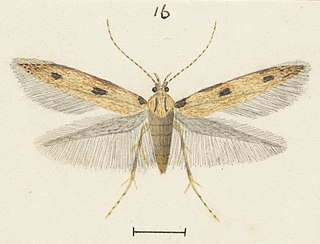
Labdia anarithma is a moth of the family Cosmopterigidae. It was described by Edward Meyrick in 1888. It is found in New Zealand and throughout Australia. Adults are on the wing from December to March and are day flying. They have been collected by sweeping bracken fern.

Elachista ochroleuca is a moth in the family Elachistidae. It was described by Edward Meyrick in 1923. It is endemic to New Zealand and has been observed in the South Island. The adults of this species are day flying and are on the wing from October until March.

Elachista archaeonoma is a species of moth in the family Elachistidae. It was first described by Edward Meyrick in 1889. It is endemic to New Zealand.
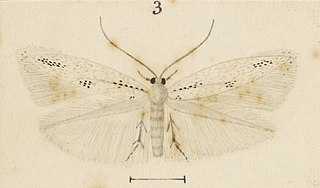
Elachista exaula is a moth in the family Elachistidae. It was described by Edward Meyrick in 1889. It is found in New Zealand.

Elachista helonoma is a species of moth in the family Elachistidae. This species is endemic to New Zealand. It is classified as "At Risk, Relict'" by the Department of Conservation.

Elachista eurychora is a species of moth in the family Elachistidae. This species is endemic to New Zealand and has only been collected at Paekākāriki. The habitat where the adult moth was originally collected was in rough vegetation on coastal sandhills or dunes but the collection locality has been significantly modified since that time. It has been hypothesised that the host of the larvae of this species is a grass. Adults are on the wing in March. It is classified as "Data Deficient" by the Department of Conservation.
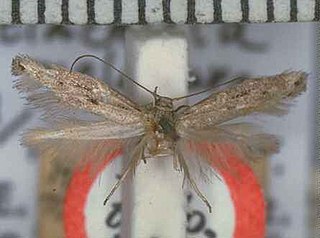
Elachista melanura is a species of moth in the family Elachistidae. This species is endemic to New Zealand. It is classified as "Data Deficient" by the Department of Conservation.

Microcolona limodes is a species of moth in the family Elachistidae. It is endemic to New Zealand. The larvae of this moth eat the seeds of endemic Myrsine species.

Anisoplaca acrodactyla is a species of moth of the family Gelechiidae. It was described by Edward Meyrick in 1907 and is endemic to New Zealand. This species has been observed in South Island as well as in the North Island. Larvae feed on species in the genera Hoheria and Plagianthus including the species Plagianthus regius'.
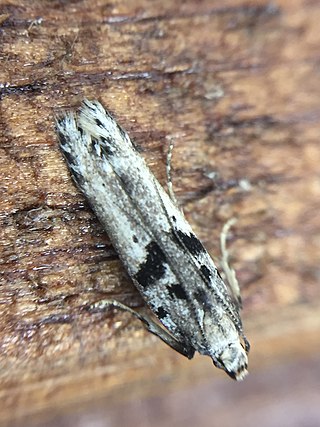
Aristotelia paradesma is a moth of the family Gelechiidae. It was described by Edward Meyrick in 1885 and is endemic to New Zealand. This species has been observed on both the North and South Islands. The larvae feed on Coprosma species creating and living in stem galls. The adults are on the wing from November to March and are attracted to light.
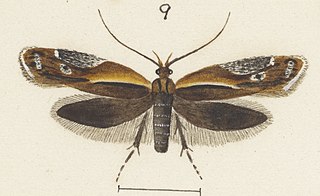
Eutorna caryochroa is a species of moth in the family Depressariidae. It was described by Edward Meyrick in 1889 and is endemic to New Zealand. This species is found in both the North and South Islands. The larvae of this species are leaf miners and prefer damp grassland habitat. The adults are on the wing in December and January. They are day flying moths, they frequent forest and scrub, and have a habit of basking on leaves in the sunshine. They have been collected by beating shrubbery.

Zapyrastra calliphana is a species of moth of the family Momphidae. It was first described by Edward Meyrick in 1889. It is found throughout New Zealand including at the Manawatāwhi / Three Kings Islands as well as at the Norfolk Islands. The preferred habitat of this species are native forest clearings, shrubland or coastal habitat such as scrub or dunes. The larvae of this species are leaf miners and are hosted by Muehlenbeckia species. There are likely several generations during the New Zealand summer and one generation overwinters as pupae. This species is a day flying moth and adults can be observed on the wing from October to March.
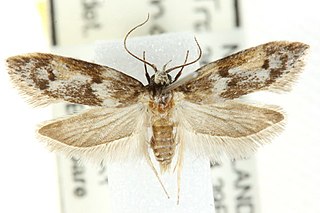
Trachypepla importuna is a moth of the family Oecophoridae first described by Edward Meyrick in 1927. This moth is regarded as having been introduced to New Zealand and is presumed to be native to Australia. T. importuna has been collected in both the North and South Islands of New Zealand. It inhabits native scrub and adults are on the wing in January and February. The placement of this species in the genus Trachypepla is regarded as being unsatisfactory and in need of revision.
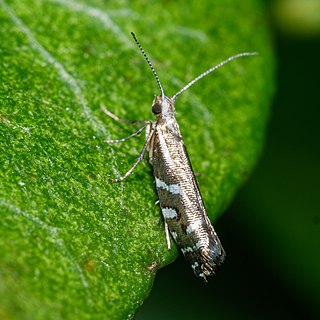
Chrysorthenches glypharcha is a species of moth in the family Plutellidae. It was first described by Edward Meyrick in 1919. It is endemic to New Zealand and is found in the North and South Islands. This species inhabits native forest with Podocarpus trees present. The larva and pupa of this species is currently unknown but the adults are on the wing in February, October and November. The adult moths are associated with Podocarpus totara and Podocarpus laetus.

Scythris epistrota is a species of moth in the family Scythrididae first described by Edward Meyrick in 1889. It is endemic to New Zealand and has been observed in the South Island. The larvae have been found on species of New Zealand broom and they pupate within an irregularly shaped, dense, silken cocoon. Adults are day flying and are on the wing from November until February.




















